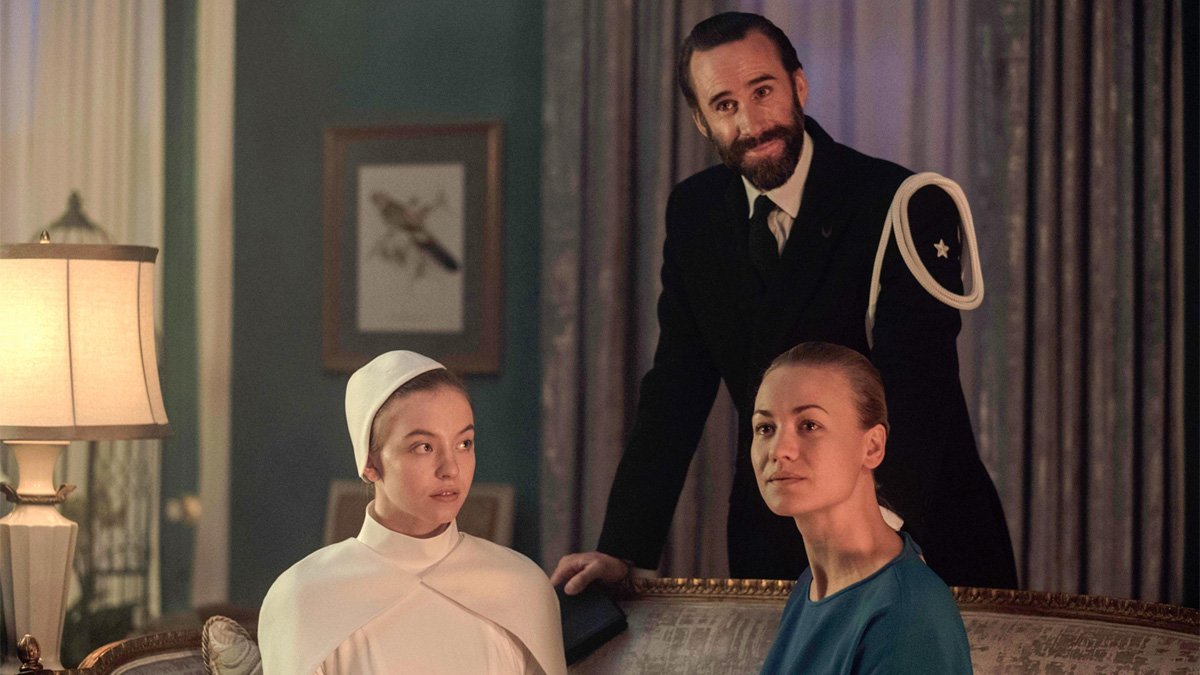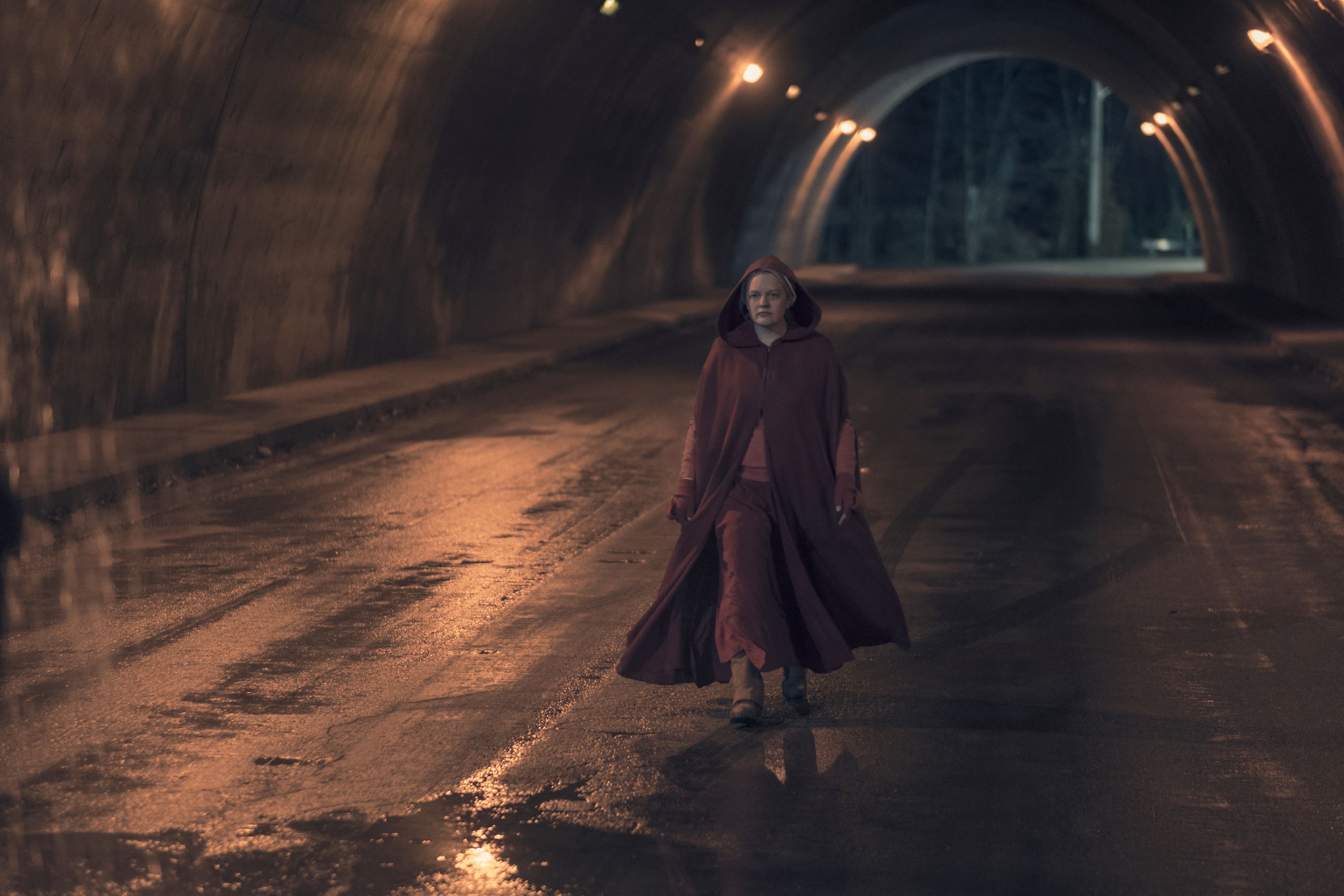The Handmaid’s Tale: How Will Margaret Atwood’s Book Sequel Affect the TV Show?
Margaret Atwood’s Testaments, out this September, is a sequel to The Handmaid’s Tale. What is its relationship to the TV series?
This article comes from Den of Geek UK.
As Game Of Thrones proved, when a TV adaptation overtakes its source material, problems can follow. Invention and expansion is required, but, even with the blessing of the original creator, on-screen continuation of a story is often treated by fans as unwelcome and non-canonical.
When Hulu’s The Handmaid’s Tale arrived in 2017, its first season covered the expanse of material from the very start to the very end of Margaret Atwood’s 1985 novel (epilogue aside, it closed on the same final image). For seasons two and three, the show expanded the dystopian world of Gilead, a fundamentalist patriarchal regime that, among other delights, forces fertile women into sexual servitude as ‘Handmaids’ to the ruling classes, and kept the story going beyond the reach of the book.
Now, with The Handmaid’s Tale renewed for a fourth season, and a sequel to the original novel arriving mid-way between seasons three and four, where does everything stand?
What do we know about Testaments?

Publication date: Sept. 10, 2019
Published by: Penguin
Announced in November 2018,Testaments is Margaret Atwood’s sequel to her 1985 modern classic The Handmaid’s Tale. It joins the story 15 years after the events of that novel. (A framing narrative for the original in the form of a fictional academic paper presented on the historical period of Gilead extends 200 years after those events, so technically, the sequel is filling in a gap instead of branching entirely out anew.)
Testaments‘ cover art (see above) was designed by artist Noma Bar, whose simplified designs contain hidden images, such as the ponytailed girl forming the collar of the cover star Handmaid. The back cover reverses the two images, with the Handmaid concealed among the ponytailed girl’s clothing.
read more – The Handmaid’s Tale: The Baby Nichole Crisis’s Real-World Parallel
The new novel will have three different female narrators, Atwood has confirmed, though their identities remain under wraps. The sequel was inspired by everything readers have ever asked the author “about Gilead and its inner workings,” and by “the world we’ve been living in,” according to the Penguin press announcement. It will be unconnected to events in seasons two and three of Hulu’s The Handmaid’s Tale (which makes sense as they take place in the time directly after the end of the original, and Testaments is set a decade and a half later on).
When asked by the LA Times why she was writing a sequel, Atwood explained that she’d been asked questions about Gilead by readers for 35 years. “It’s time to address some of the requests.”
The Trump administration too, was part of her explanation. Atwood described herself “like all Canadians” watching US politics and thinking “What kind of shenanigans will they be up to next? What’s gonna happen next? I’ve never seen anything like it, and neither has anybody else. On one hand, it’s just riveting, and on the other hand, it’s quite appalling.” True and true.
Testaments isn’t Margaret Atwood’s first addition to her original novel

In 2017, an “enhanced edition” of The Handmaid’s Tale audiobook – as read by Claire Danes in 2012 – was released. This version by Audible not only added snippets of music in between chapters (to represent the cassette compilation tapes over which Offred recorded her story in the original novel), but also extended the epilogue.
read more: The Handmaid’s Tale Season 3 Depicts a Seismic Shift in Gilead
Originally, The Handmaid’s Tale novel ends with the ‘transcription’ of a fictional conference paper presented by an academic researcher in Gileadean studies, 200 years after the events of the story. It’s a sly, satirical piece of writing that concluded with the line “Are there any questions?” In the 2017 edition, questions are asked. Audience members – one voiced by Margaret Atwood – ask speaker Professor James Darcy Pieixoto a series of points about his paper and the workings of Gilead. During the Q&A, there’s even mention of the historical discovery of Aunt Lydia’s logbook from the era, which turned out to be a hoax. The session ends with a tease for the sequel, as the Professor tells his audience “I hope to be able to present the results of our further Gileadian investigations to you at some future date.”
On September the 10th this year, that’s exactly what’s going to happen.
What is Atwood’s relationship to The Handmaid’s Tale TV show?
Atwood is a Consulting Producer on Hulu’s TV adaptation of her novel, which doesn’t mean, as she told Toronto Life back in April 2017, that she has the final say in story or otherwise, but that she’s part of the conversation: “It means that the only person who knows what the characters had for breakfast is me. I’m the historical consultant.”
Showrunner Bruce Miller told The Hollywood Reporter in January 2018 that Atwood “plays a huge role” in the series as “the mother of us all.”
“She was in the writers’ room very early in the season,” said Miller about the second season. “We’ve been talking throughout, and she’s been reading everything. She’s very involved. She’s our guiding star, and always has been.”
The team’s goal, he explained, is to “make sure the “Atwoodness” of the show stays front and centre. Even though we’re going beyond the story that’s covered in the book, in some ways, we’re still very much in the world of Margaret Atwood’s The Handmaid’s Tale.”
In the season one premiere, Atwood had a dialogue-free cameo as an authoritarian Aunt who strikes Elisabeth Moss’ June during her training at the RED centre, where Handmaids are prepared for their postings:
Speaking to The Independent in June 2019, Miller confirmed that he is is regular contact with Atwood. “She reads all the scripts. She sees episodes, and so she feels the same way, I think – that it’s a good extrapolation of her world.”
So the expanded Gilead of seasons two and three, which travelled to the Colonies and the Econovillage, locations only mentioned in passing in the original novel, will not influence Testaments.
Seasons two, three and four of the TV show continue to draw from the book

Though The Handmaid’s Tale TV show outran the novel by the end of season one in terms of timeline, elements from the book are still being used up by the television series. In season two, the first “Prayvaganza” was staged, a Gilead ceremony from the novel in which girls as young as fourteen are married off to men in a mass ceremony.
In season three, viewers first witnessed the act of “particicution” by hanging as described in the novel, in which multiple Handmaids pull on ropes joined to one set of gallows, as a form of “salvaging.” Also in season three, June discovers and records a message on a compilation cassette in the basement of her latest posting, as a reference to the tapes on which Offred’s original testimony was discovered in the novel.
Speaking to The Independent in June 2019, showrunner Bruce Miller described how June’s season three inner monologue line about her mother always wanting a “women’s culture” and Gilead has created one, but not the one she envisaged, was taken straight from the book. “We spent kind of three years teasing that quote apart,” said Miller. “We have quotes from the book up all over the place.”
So even though the timeline has strictly run out, we can expect details from the novel to emerge for exploration in future seasons of the TV show, and presumably the same will apply for Testaments.
Testaments will make the TV show harder to write

Speaking to The Independent about the relationship between the original novel and the TV adaptation, showrunner Bruce Miller brought up Testaments. “But now Margaret’s writing a sequel,” he said, agreeing that would make it “interesting”.
“The degree of difficulty was 10 and now it becomes 10 plus,” said Miller. Navigating the expanded world of Gilead he and his team have created while remaining truthful to the vision Atwood lays out in Testaments will be some balancing act.
How many seasons will the TV show go on for?

Season four of The Handmaid’s Tale is expected to arrive in 2020. According to a very early plan by showrunner Bruce Miller, there would then be a further six seasons still to go after that. Miller told The Hollywood Reporter in 2017 that he had originally “roughed it out to around 10 seasons”, but has since confirmed to Mashable that there is no exact target in terms of the number of seasons, more a narrative point he wants to reach.
“The ideal for the show’s longevity is that when it’s done there’s something kind of nice and perfect that you can put on the shelf next to the book as a companion piece, said Miller. “There is no number, and considering that seasons can get longer and shorter has made that even more meaningless.”
Miller told Mashable he wants to take the story all the way to Gilead’s own version of the Nuremberg Trials after the fall of the regime, when Serena and Commander Waterford are forced to answer for their crimes. “We can go on for a very long time,” he promised.
Keep up with all our The Handmaid’s Tale season 3 news and reviews right here.
Read and download the Den of Geek SDCC 2019 Special Edition Magazine right here!
